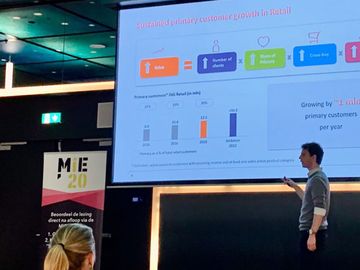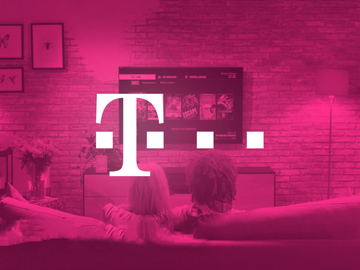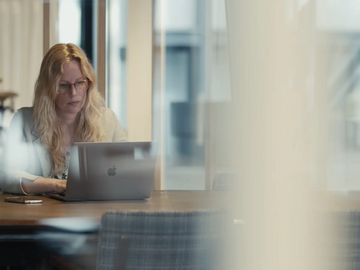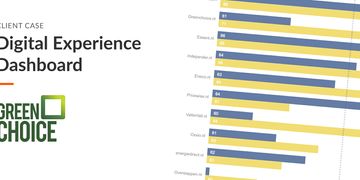
How our clients work with the Digital Experience Dashboard: Greenchoice
In Q4 2020, WUA set up chats with our dearest clients to talk about “The New WUA”: the product and organizational shift WUA is making with the Digital Experience Dashboard taking a huge role. In this edition: Didy Bos, senior online marketeer at Dutch energy provider Greenchoice.
Hi Didy, thank you for making this case happen! Let’s start with a short intro: What does your job entail at Greenchoice? Can you tell us a bit more about your role and the organization you work in?
“Greenchoice is a Dutch green energy supplier. We’re not only saying we are ‘green,’ we actually really ARE. All our gasses are forest-compensated, the electricity we deliver is mostly Dutch wind energy and we also deliver solar power. A fact on Greenchoice that is quite interesting in this light: we’re one of the largest forest protectors in the world, and that’s something I’m also personally proud of.
“We’re not only saying we are ‘green,’ we actually really ARE.”
“So my role is senior online marketeer. I’m in the marketing team and we have three subteams. The first subteam is focused on brand and communication, the second on proposition, renewal and loyalty, and I’m in the third subteam: Digital and Customer Experience. We focus on the digital platforms, on online customer experience and on advertising. Customer experience is one of the most important aspects of marketing at Greenchoice. It’s in almost everything we do. My core focus is on website optimization for user experience, sales and retention.”
What are the big digital challenges you and the teams have to cope with at Greenchoice to accelerate digital growth, and how do you manage?
“There’s so much going on in the digital landscape, but I think one of the big challenges at Greenchoice is for us to be efficient. At the same time, we want to deliver great customer value with great customer service and a smooth overall customer experience. We’re the biggest green energy player, but our competitors have bigger budgets. We want to spend our budget on sustainability instead of marketing, so we are quite thoughtful about our spending and we really focus on input vs output.
“Let me give you a quick example of how we tackle the efficiency challenge: Last year, we rebuilt our website with a component library, which means our front-end code is built up of separate components. Each component can be combined to create a new page. You can set up new pages quite fast, and the code is very consistent, so it’s easier to maintain the website.
“We want to achieve great customer service and smooth customer experience by being data driven. That’s where WUA and the Dashboard come into play. We also do a great deal of usability research and customer satisfaction research. This gives us further guidance on what to do and what not to do.”
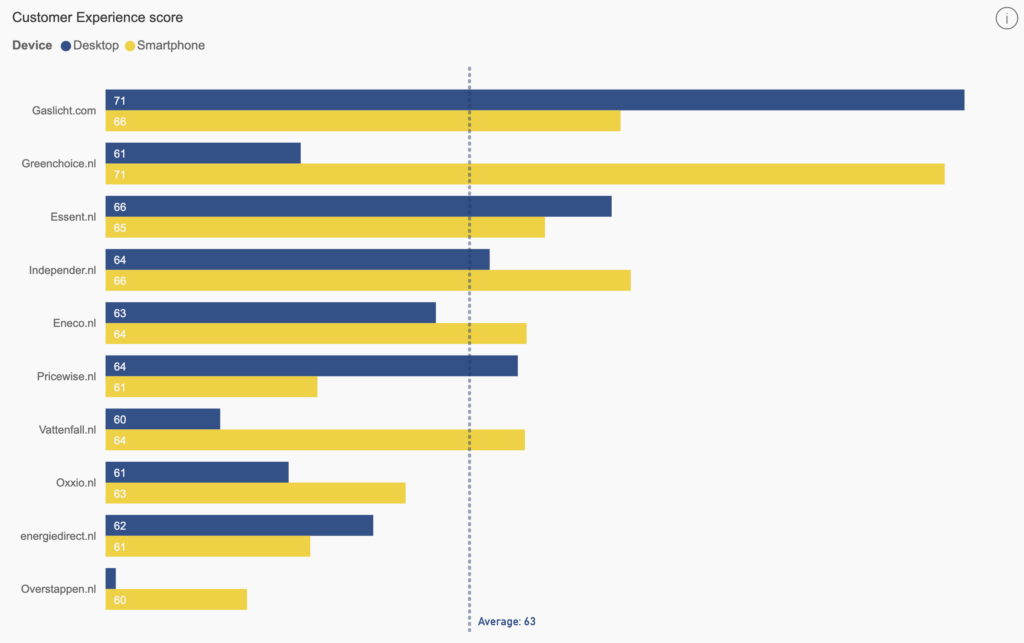
At Greenchoice, you’ve worked with the Digital Experience Dashboard for a while now. Can you elaborate on your approach? How do you work together with the team(s) on this?
“We started working with the Digital Experience Dashboard in May 2020. We had great assistance and backup from WUA’s research department and we had an extensive kickoff with your consultants about all the ins and outs of the Dashboard. That really helped us to get started!
“We are planning Dashboard sessions every three months. It’s an online brainstorm session, where I take the lead. During this session, we identify website issues or funnel hiccups, and the Dashboard is the main starting point for that. Our data analyst is involved in these sessions. She’s accompanied by our Team Coordinator CX and our CX marketeer. The team coordinator can help us distribute the insights within the company, especially if a topic or insight is broader than only digital. If we find improvements on a proposition, for example, she can contact my colleagues who are responsible for propositions. We use the Dashboard a lot for our a/b testing input. Some optimizations we’ll just implement, and some changes we like to a/b test first.”
““We use the Dashboard a lot for our a/b testing input.”
How and based on what do you decide to change and adapt your online environments directly, and when do you make the call to set up a/b tests?
“It depends on the page, or maybe it is based on gut feeling, I must admit. But… we also have an unwritten rule in place. If an optimization concerns the homepage, pricing or the subscription page, then we always test it. If an optimization concerns a bug, or if it’s experienced as a flaw by consumers, we change it directly.
“If the problem is bigger, then we test. For example, we have a lot of content pages. Those pages are difficult to test, because the volume is not that high. On content pages, we change based on data and research. Sometimes, we also test the content pages through a quick usability test.”
What specific topic or feature of the Dashboard has the most value/do you find most useful or interesting?
“When I use the Dashboard, I focus on the open answers: you’ll find the problems consumers are having and the context there. And, more recently added to the Dashboard, I find the Prioritization feature very useful and we’re using it more and more (check out this product video). With this feature, you can easily find what to improve first, also on the question level and theme scores. There’s so much data in the Dashboard, so I think you really need to know where to focus. This feature is going to save us a lot of time!”
“I find the Prioritization feature very useful and we’re using it more and more.”
What results and improvement are you most proud of, using the Digital Experience Dashboard?
“One of the issues the Dashboard helped us with, was identifying that we had a ‘zigzag problem’ on our content pages. Our information and content pages are quite playful, as Greenchoice has a somewhat playful brand style and we have a zigzag pattern on our content pages. On mobile, we have the highest scores, but on desktop, we don’t. So, we realised it had to do something with the presentation of the content. Seeing the difference between the devices really helped us pinpoint on this specific problem. We would not have found this without this Dashboard, because there’s a split in the devices between desktop and smartphone scores.”
“One other example of a possible improvement we found using the Dashboard: we need to make things simpler for our customers and our potential customers. We’re quite focused on explaining about sustainability. But sometimes our visitors and clients find it difficult because they get info-overloaded.

“So, last week, we launched our new pricing page, where we are offering only one source of green energy (see the above screenshot, MvdB). We will be making it easier for our potential customers: all our energy is green, so why not make that green choice easier for our customers?
“We’ve found in the open answers in the Dashboard that we provided so much detail that people sometimes tune out. So, the Dashboard helped us with the funnel and with optimizing the different phases in our funnel. The Dashboard is organized in a funnel, from Findability to Preference and Order Process. This really helped us identify the problems in the Greenchoice funnel.
“And, last but not least: we’re comparing our results with the previous measurements. They are all delivered in one Dashboard, so you can easily access them. That’s also a feature I find really helpful.”
